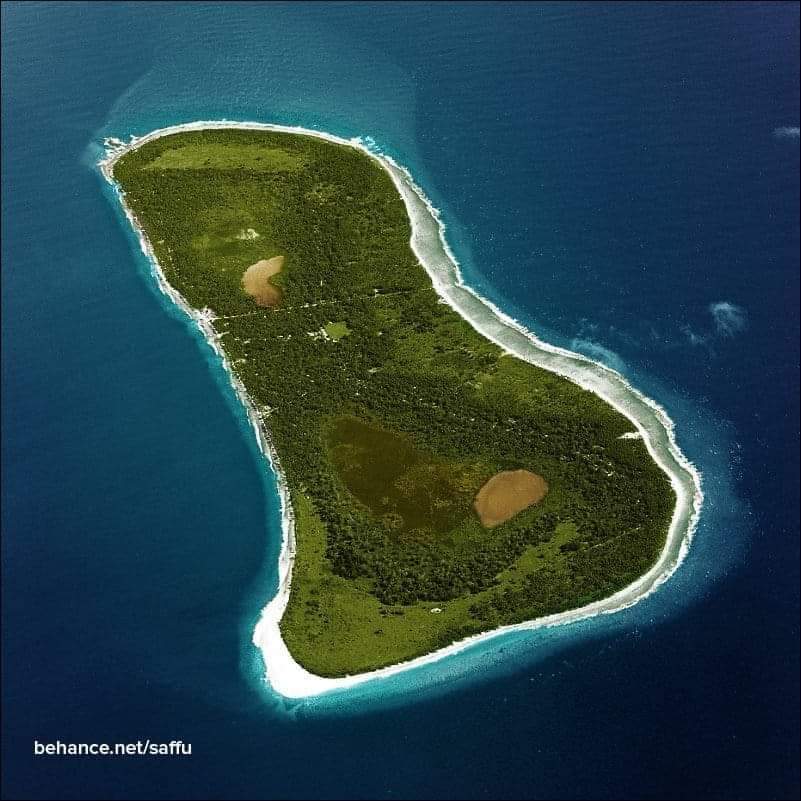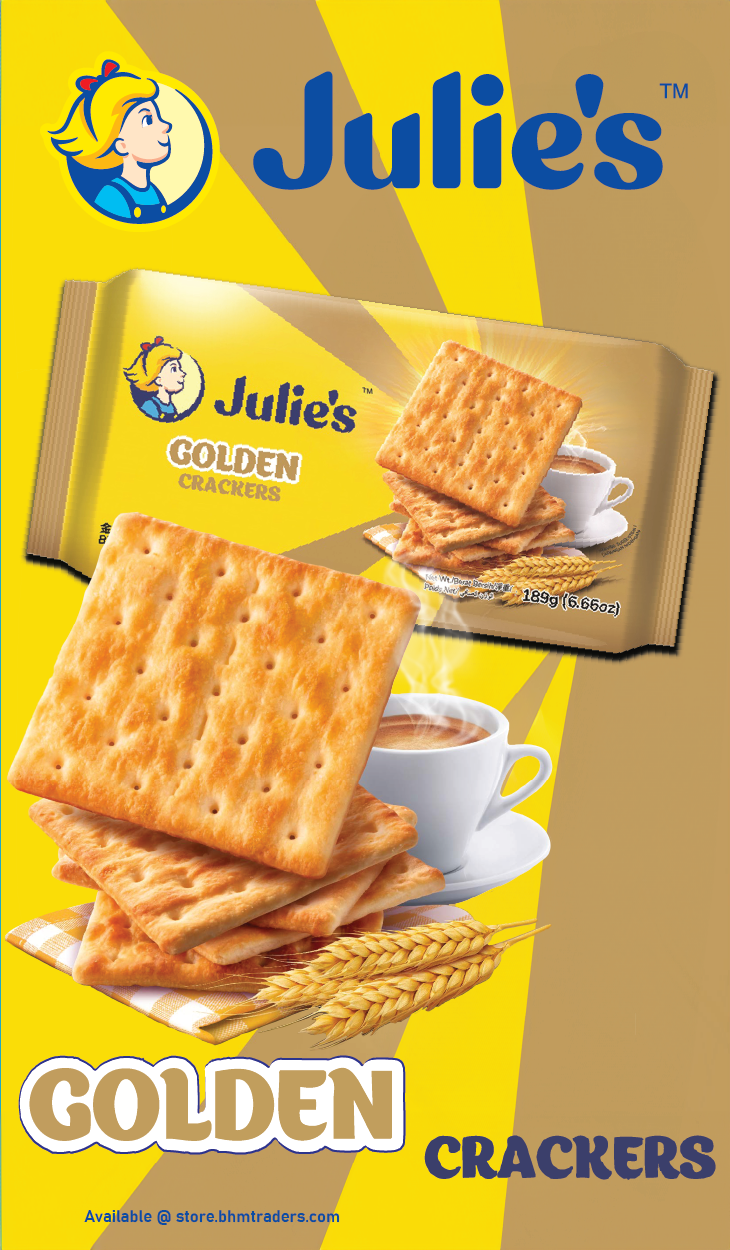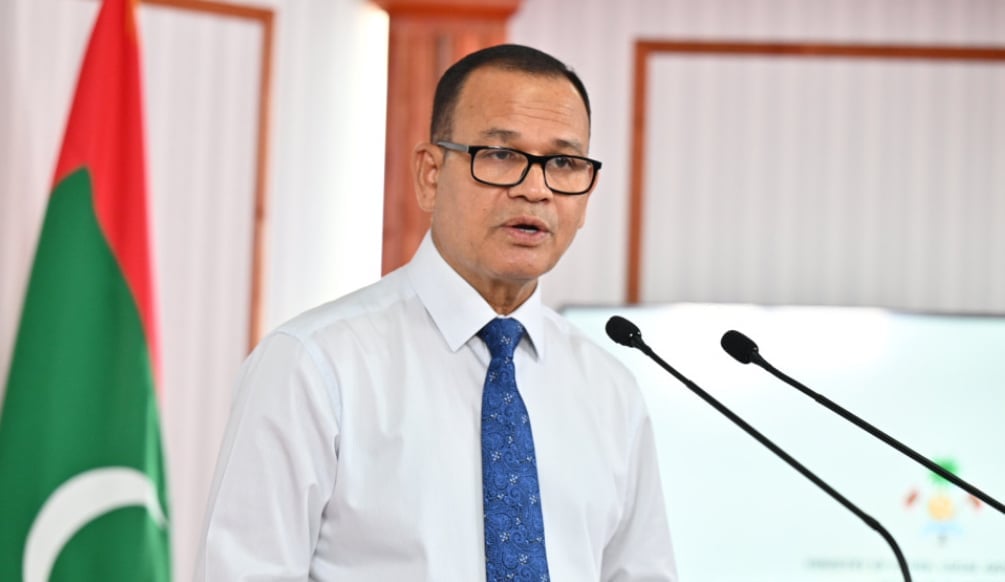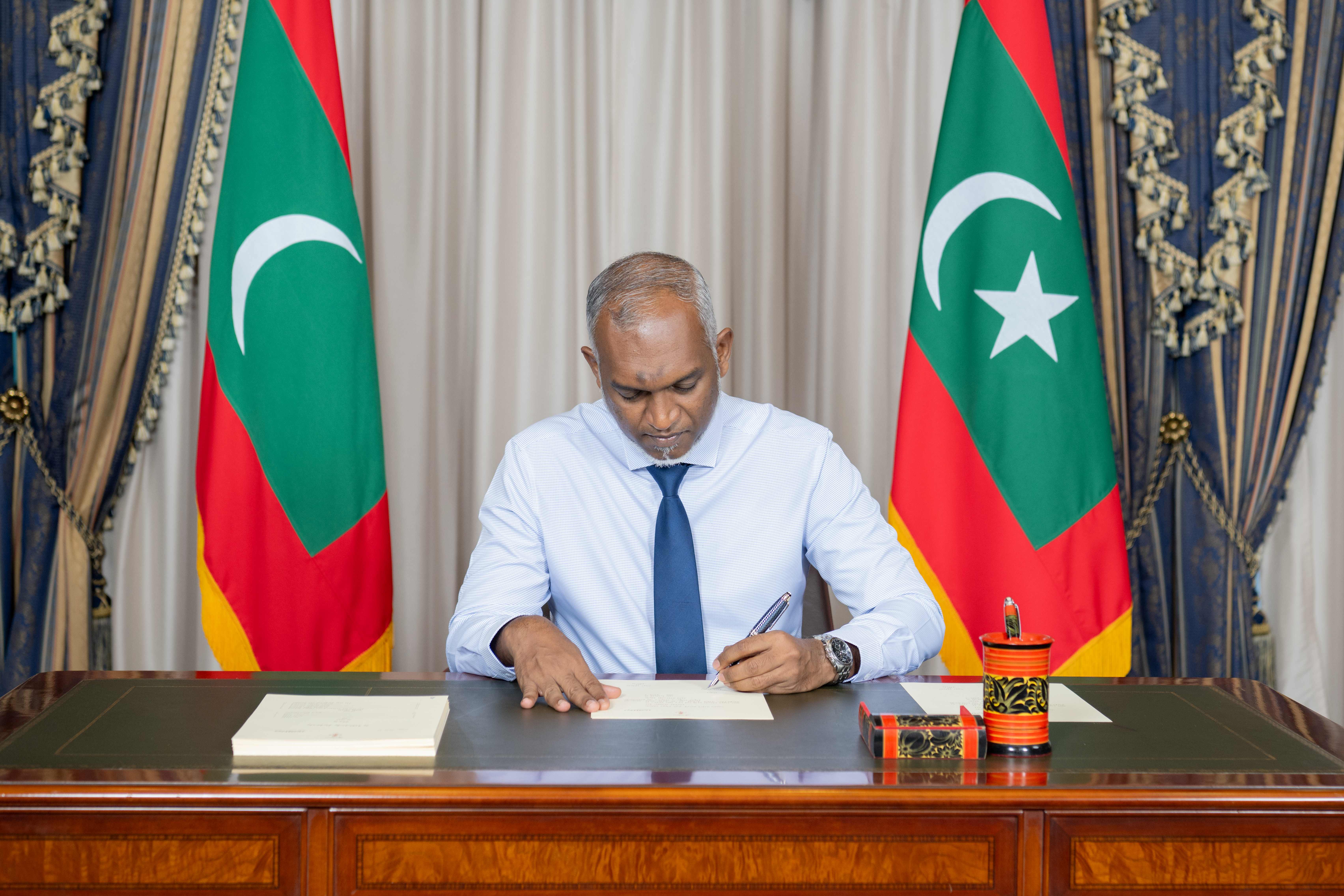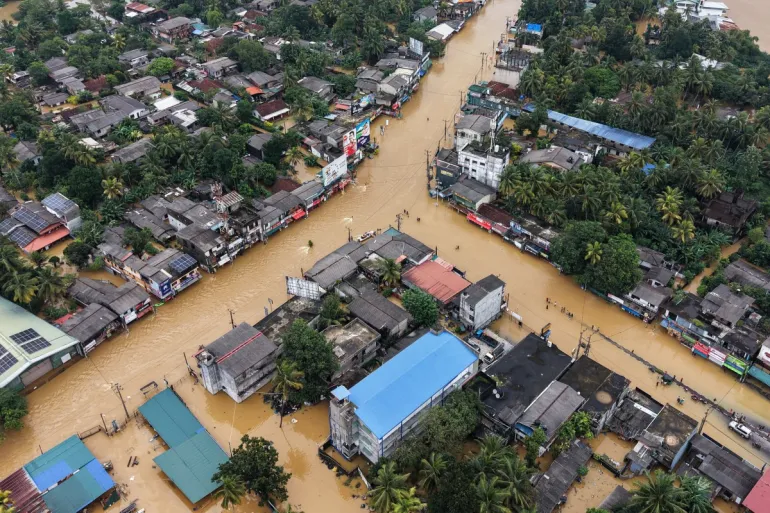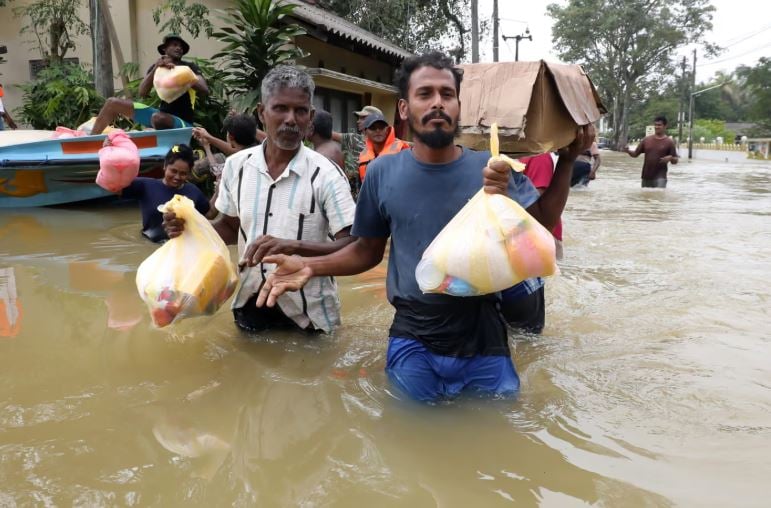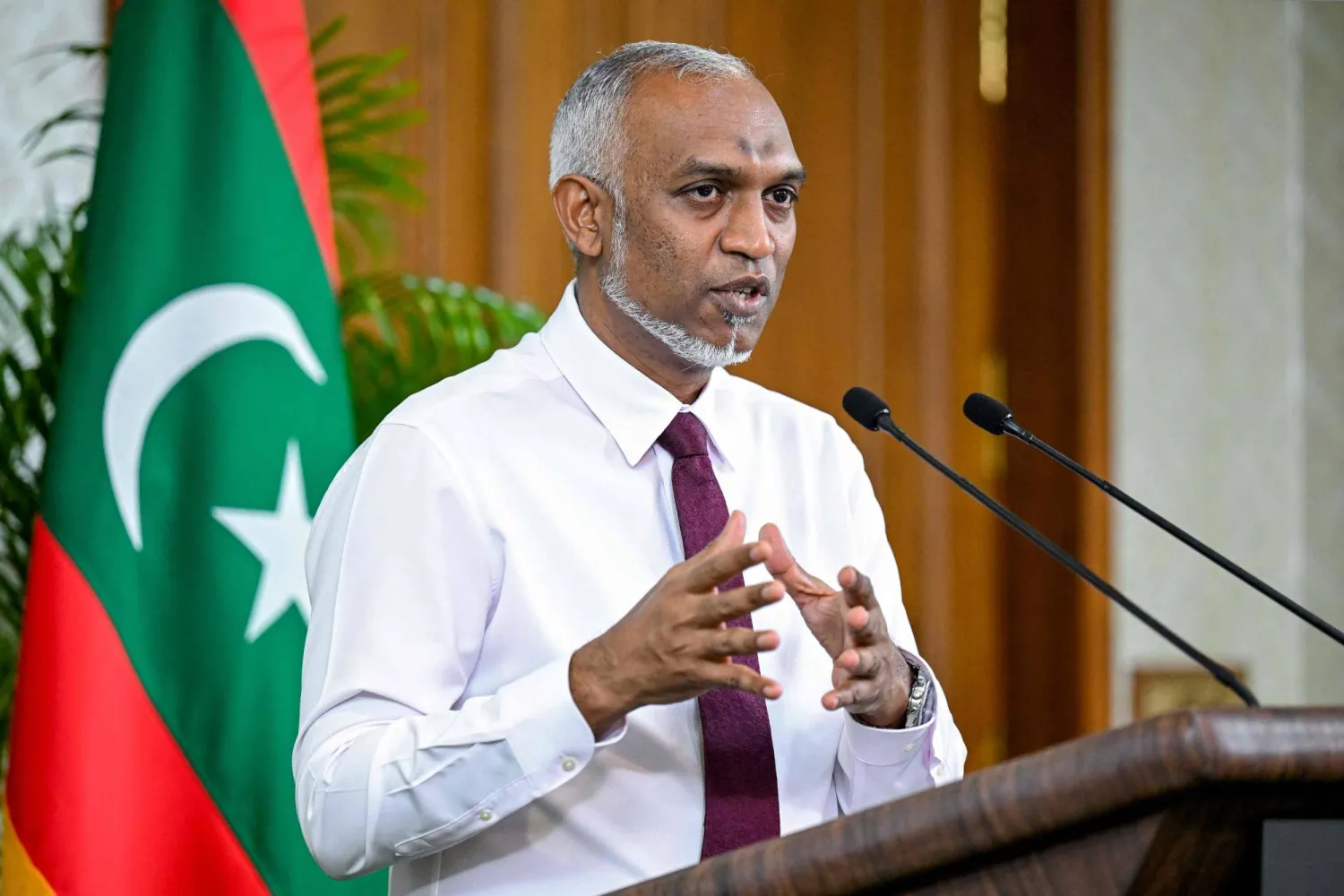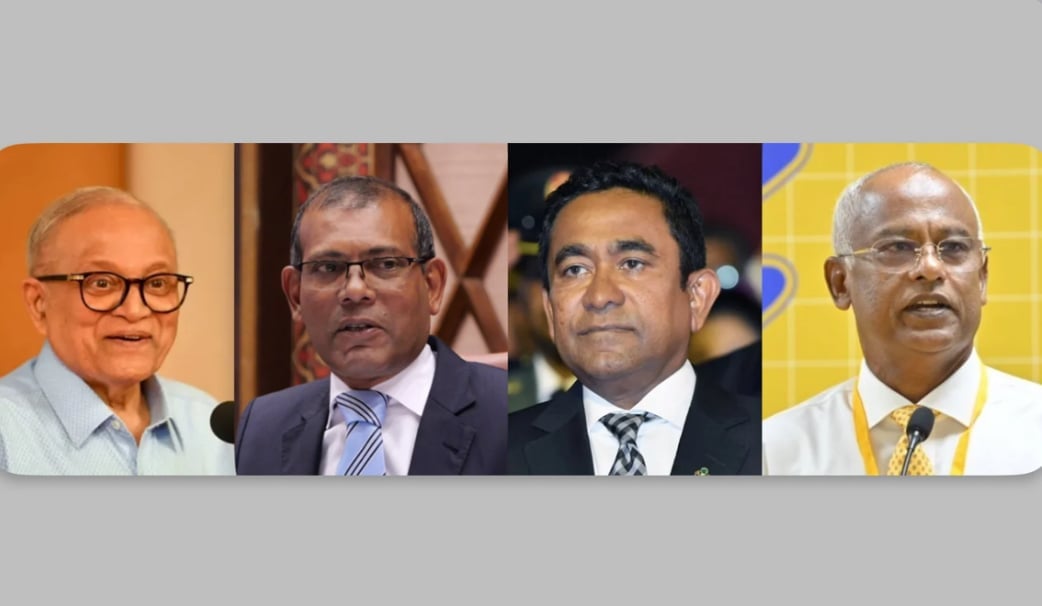Fuvahmulah is the most unique atoll and island in the Maldives. This uniqueness is inherent to Fuvahmulah as a result of its geographical formation. Fuvahmulah is also a historically significant island. It is considered one of the islands where the earliest inhabitants of the Maldives lived. It is also an island rich in sites and artifacts from the Buddhist era of the Maldives, as well as Islamic heritage that existed in the Maldives for over eight hundred years.
Fuvahmulah, one of the two atolls south of the equator, is the country's third-largest island. Its area is roughly 5 square kilometers. Fuvahmulah features two inland freshwater lakes. Fuvahmulah, which is surrounded by a reef but lacks a lagoon, is the closest to Addu Atoll, followed by Huvadhoo. In addition to its size, Fuvahmulah boasts a sizable population. It is the third-most populous island in the Maldives.
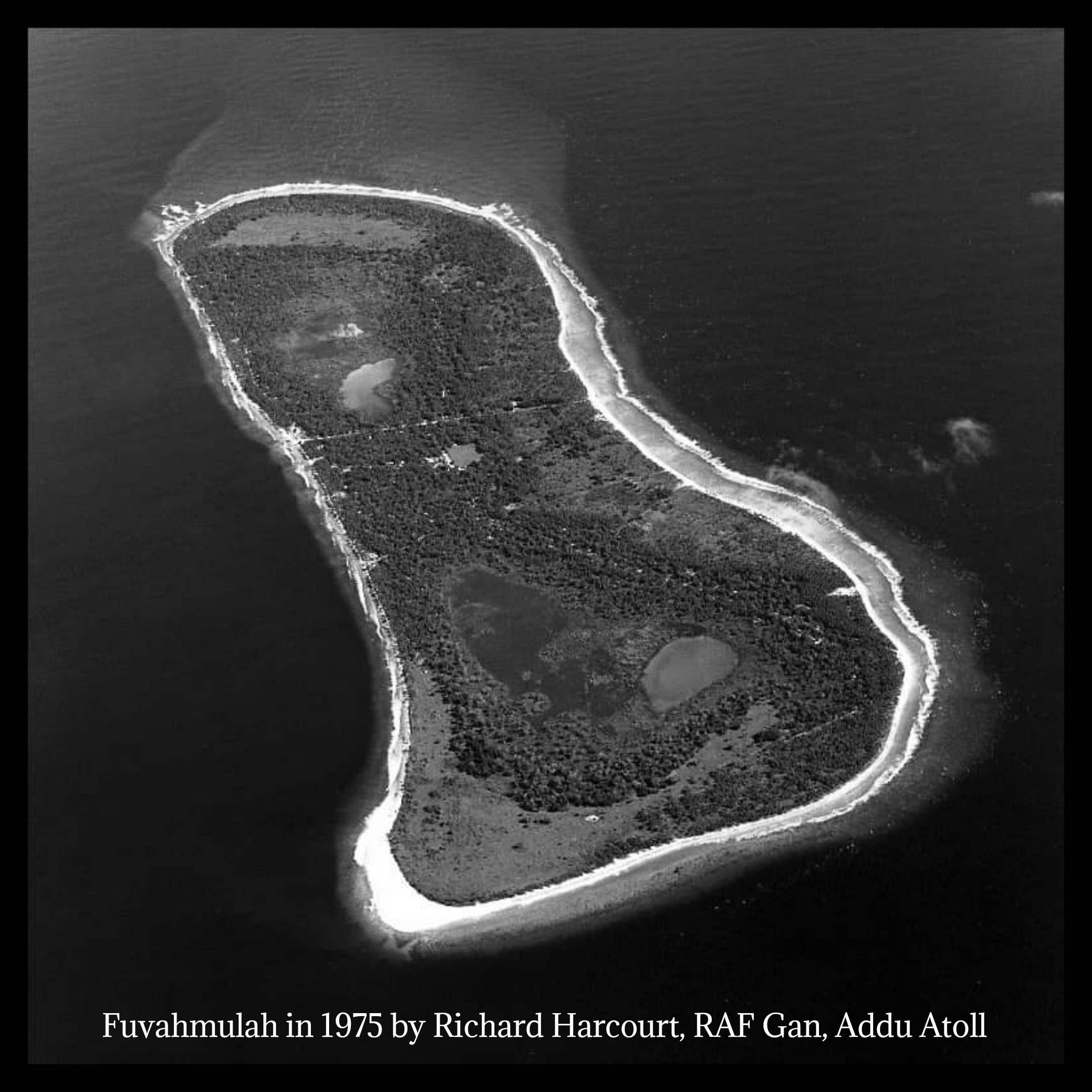
The main sources for this article about Fuvahmulah a century ago are H.C.P. Bell's "The Maldive Islands. Monograph on the History, Archaeology and Epigraphy" and a study based on Maldives census data from 1921. H.C.P. Bell visited the Maldives three times, gathering detailed information, conducting research, and producing books and articles on the Maldives. He came to the Maldives in 1879, 1920, and 1922. During his third voyage, he also visited Fuvahmulah.
Looking back a century, Fuvahmulah was considerably different from what it is today. The image below the headline also beautifully depicts the difference between today's Fuvahmulah and what it looked like half a century ago. That photograph was taken 49 years ago by Richard Harcourt, who worked at the British Royal Air Force Base in Gan, Addu Atoll. The original photo was black and white. It was colorized by Ahmed Saffah. Fuvahmulah would have looked the same even a century ago, despite the fact that the photo was taken 49 years ago.
Fuvahmulah had no harbour or airport a century ago. At the time, there were three channels to reach this island, which was surrounded by a shallow reef where large waves broke. These included Dhiarehifaa'ndu, Maaneyru, and Rasgefandnu. Rasgefandnu was the most commonly used channel.
Bell stated that at the time, the island was regarded to have the most lush vegetation and fertile soil in the Maldives. The island was primarily a jungle, dominated by coconut trees. Because there were lots of trees in the courtyards of the houses and no roads like there are now, one would not see it from above as a thickly populated island. The people of the Maldives back then had a great passion for trees and led eco-friendly lives. They wouldn't uproot a tree unless it was absolutely required. More trees would be planted than taken down.
The population of Fuvahmulah was little over two thousand a century ago. The 1921 census states that there were 2,186 people living in Fuvahmulah at that time, 1,143 of them were men and 1,043 of whom were women. It had the largest population at the time, after Male'. Hithadhoo, Addu Atoll, which is currently in second position, had 1,771 residents at that time.
As previously stated, because Fuvahmulah was such a fertile and large island, agriculture was the primary employment for the majority of the population. In this regard, a total of 560 persons, including 317 women and 243 men, were working in agriculture. The island was home to 162 fishermen during those days and there were 105 persons working as toddy tappers. These two occupations were primarily male-dominated.
Around a century ago, among the people of Fuvahmulah who worked in various occupations for a living, there were 72 women involved in lace making and stitching, as well as one woman and 41 men in clothes weaving. There were also 22 male carpenters, 13 male blacksmiths, 7 male goldsmiths, 2 male fandithaverin (traditional healers), and 6 men and 5 women who worked as traditional medicine practitioners. At the time, Fuvahmulah was said to have only one midwife and one astrologer. Seven men and six women were involved in teaching the Holy Quran. Only one person on the entire island wove cadjan, and one person made fishing nets. While 18 men worked as traders on the island, 172 individuals were employed as servants, which included 113 women and 59 men.
Bell stated that Ahmad Didi, a great-grandson of Prince Ibrahim Faamuladheyri Kilagefaanu (son of Sultan Muhammad Ghiyasuddin), was engaged in stone carving, specifically in the making of tombstones, despite the occupation not being recorded separately in the census. Bell, who visited the island in 1922, stated that there was only one blacksmith at the time, Fengan'dumagu Muhammad Didi, despite the 1921 census listing thirteen blacksmiths. Bell may have visited the island when the other blacksmiths were away.
When Bell visited, he noticed that a small and completely unexpected industry had begun on the island. That was soap making. According to Bell, this locally produced soap was created using ashes, coral lime, and coconut oil. Soaps were offered to him in three colours: cream, mauve, and pink, with oblong or oval shapes. According to him, the design was well-executed. The words "Mulaku" or "Sábun Mulaku" (meaning "Soap of Mulaku") were written in Arabic on an oval or diamond-shaped panel. Occasionally, the owner's name, "Ahmad Didi," "Best Soap," and "Made in Mulaku" appear, with every word capitalized in English.
Fuvahmulah had 560 farmers, however they did not grow grains. The farmers primarily produced tuber crops. In addition, they grew various fruits and vegetables. According to Bell, in addition to coconut palms, breadfruit, and bananas, Fuvahmulah grew mango, custard apple, rose apple, jamun, pineapple, and citrus fruits. Bell claims that there is no evidence that the island has ever experienced food shortages. It was a self-sufficient island with a surplus of what was generated on its land and got from the sea.
Fuvahmulah was administratively divided into 'avah' or wards, like are the other major islands in the Maldives. At the time, there were nine wards on the island. The wards were: Dhadimagu, Dhiguvaan'du, Hoadhadu, Dharhukubaa, Maadhadu, Maalegan, Dhoodigan, Miskiymagu, and Funaadu. These nine wards had a total of 443 houses. This consisted of one Naaibuge (court house), thirteen Edhuruge (teaching houses), and eleven medicinal houses. During this time, only one house in Fuvahmulah was constructed of coral stone and roofed with corrugated iron sheets. There were 14 coral stone houses with thatch roofs, while the others were made of thatch and wood. There were 48 Maizaange (public assembly houses) in Fuvahmulah at the time.
According to the census of 1921, Fuvahmulah had 26 mosques. However, Bell said that there were 25 mosques. The two largest mosques were the Hukuru Miskih (Jumah or Friday Mosque) in Maalegan and the Eidhu Miskih (Eid Mosque) in Dhadimagu. The Eid Mosque was locally known as Gen Miskih. According to Bell, the island's oldest mosques were Henehari Miskih, Hoadhadu Miskih, Kedeyre Miskih, and Ufurajehi Miskih. However, historians believe that the oldest mosque is Gen Miskih, which was built by Abu Bakuru Naaib Kaleygefaanu, who introduced Islam to the island. The mosques Bell describes were constructed much later. In any case, because this essay is about Fuvahmulah a hundred years ago, we will not go into detail about the island's early history.
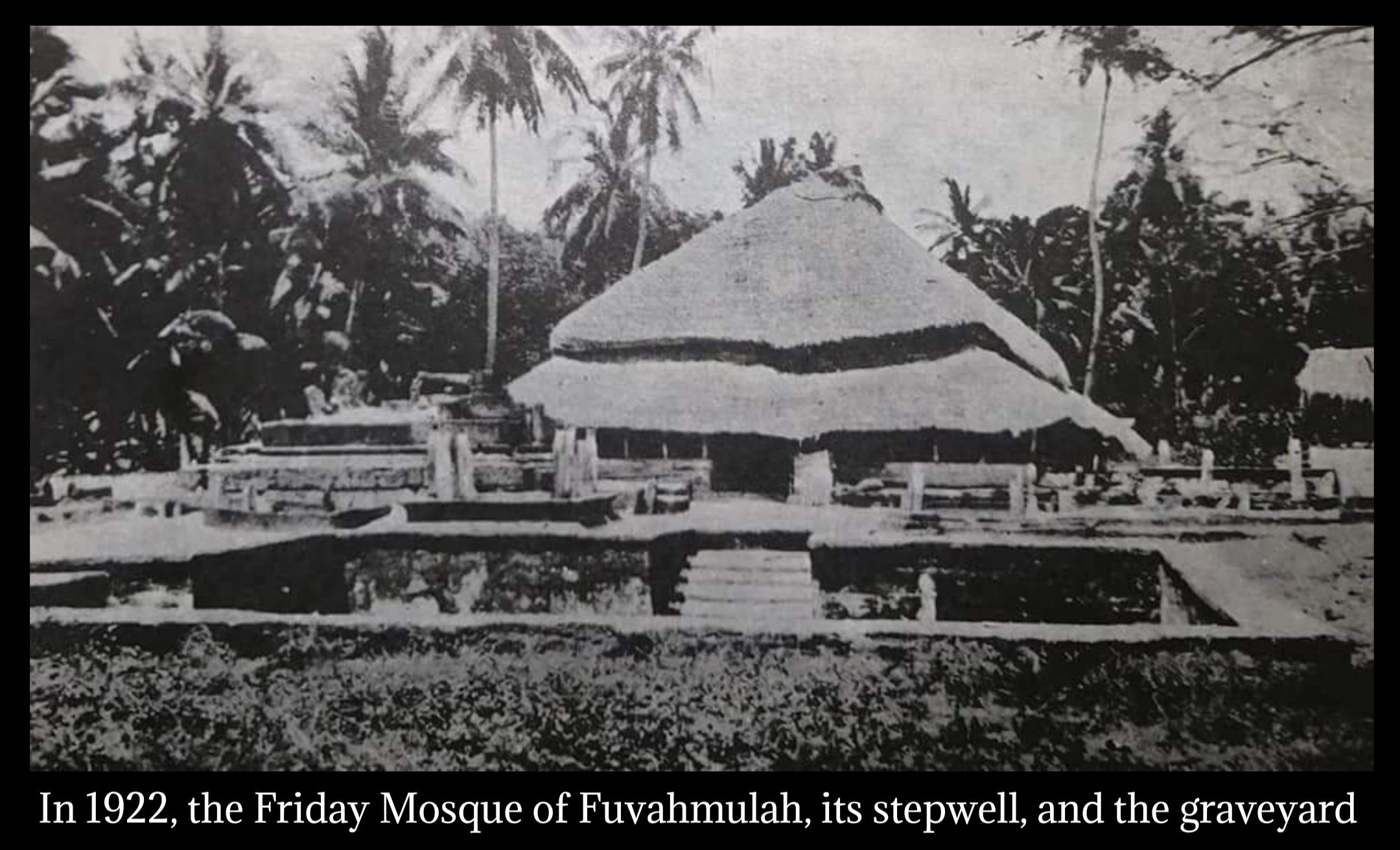
Each mosque, like all other islands in the Maldives at the time, had an attached cemetery or graveyard. In addition, there were a few additional cemeteries spread over the island. Fuvahmulah had a total of 35 cemeteries according to the 1921 census.
In ancient times, one special structure associated with mosques in the Maldives was the stepwells or the bathing tanks located mostly near the mosques. There were a lot of these stepwells at the larger, primary mosques and other public places on the island. There were also stepwells in private residences on a few islands. A hundred years ago, the island with the most stepwells in the Maldives was Fuvahmulah, with 426 stepwells. During that time, there were a total of 1,880 stepwells across all islands in the Maldives. Along with Fuvahmulah, the atolls with the most stepwells in the Maldives were Addu Atoll, Huvadhoo Atoll, and Male'. This included 426 stepwells in Fuvahmulah, 567 in Addu Atoll, 594 in Huvadhoo Atoll, and 77 in Male', totaling 1,664 stepwells. This accounted for approximately 90% of all stepwells in the Maldives.
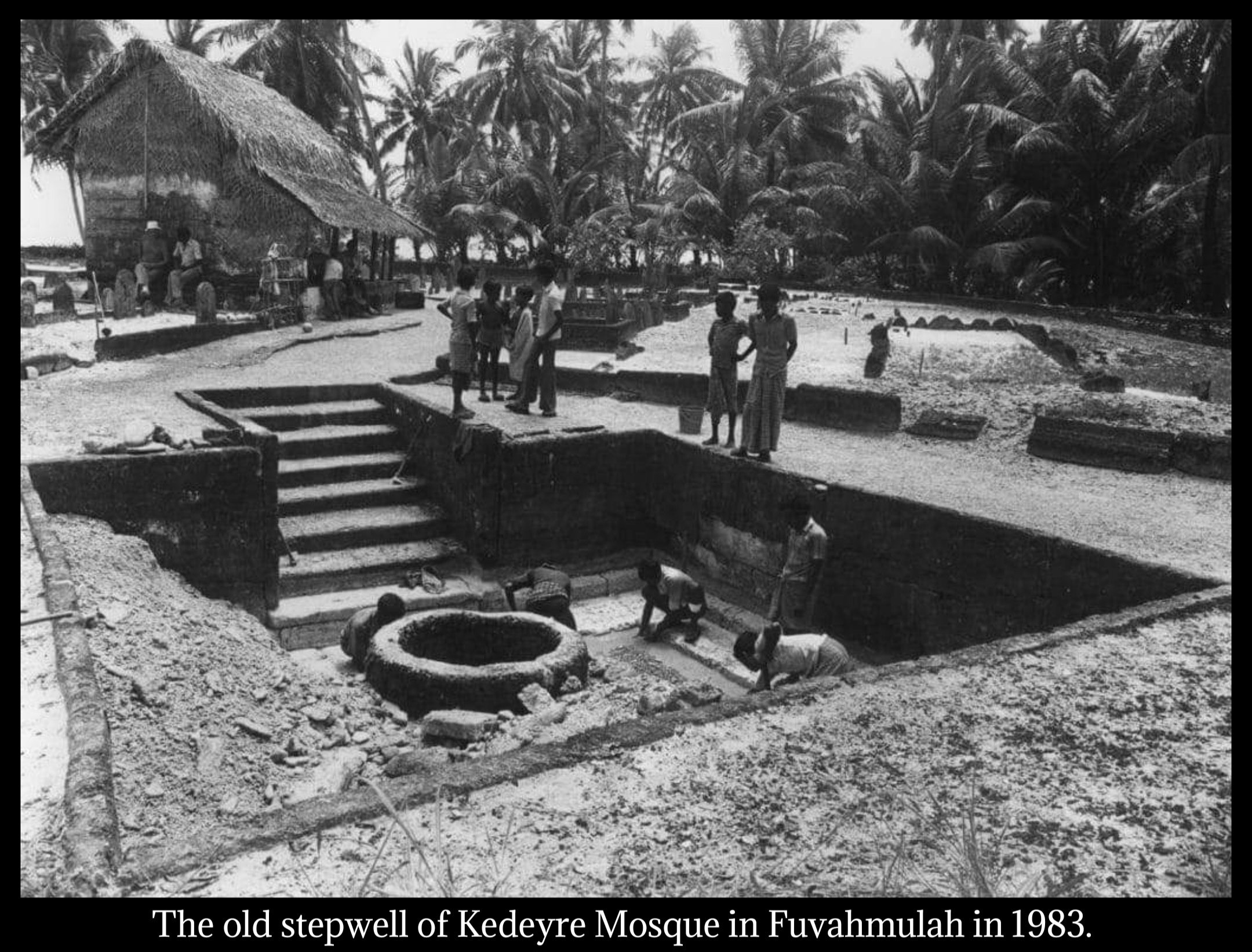
In the 1930s, a law was passed to remove public stepwells from islands throughout the Maldives, and as a result, the stepwells in Fuvahmulah were filled up, buried, or demolished. The World Health Organization's recommendations resulted in the eradication of practically all stepwells in the southern Maldives by 1952; the stepwells that remained in Fuvahmulah were either buried or demolished.
Like every other island in the Maldives at the time, Fuvahmulah was home to a large number of shrines and Ziyaaraths (tombs) of notable people. Five of these ziyaaraths were thought to be the most special, according to Bell. He did not, however, include all of the names of these ziyaaraths. He did, however, note that Abdu Naaib Kaleygefaanu's shrine was the most revered.

Bell reported that there were eight Katheebs in Fuvahmulah for leading religious services, such as Friday and Eid prayers in the mosques; however, the census records only listed six Katheebs. This difference could be attributed to the absence of some Katheebs from the island, vacant positions, or other factors. Like the Hukuru Miskiiy (Friday Mosque) in Male', the Hukuru Miskih (Friday Mosque) in Fuvahmulah also had a Maa Mudhim and five lessor Mudhims working under him, in addition to a Malin.
A Naaibu (Deputy) served as the senior officer in charge of Fuvahmulah's judiciary at the time. This Naaibu was, in fact, a subordinate judge serving as a deputy of the Chief Justice of the Maldives. However, at the time, only the Chief Justice in Male' was referred to as a judge (Fan'diyaaru), and those who worked under him were referred to as Naaibus. The aforementioned Naaibu in Fuvahmulah was assisted by four Dheyvanis.
The Goiverin was in charge of supervising government-owned land (Bandaara bin) revenues in Fuvahmulah. Bell claims he was also the island's highest-ranking government official or the Chief Island Headman. Ali Didi, the son of Hirihamaadhi Kaleygefaanu, served as Fuvahmulah's Goiverin a century ago. However, some historians believe that, like other Maldivian atolls, Fuvahmulah's highest-ranking official at the time was a Vaaruverin (Government Tax Collector). According to them, Ali Didi was the Vaaruverin, as well as the Goiverin. In atolls with Vaaruverin, there were also separate Goiverin who managed and supervised the bandaara lands.
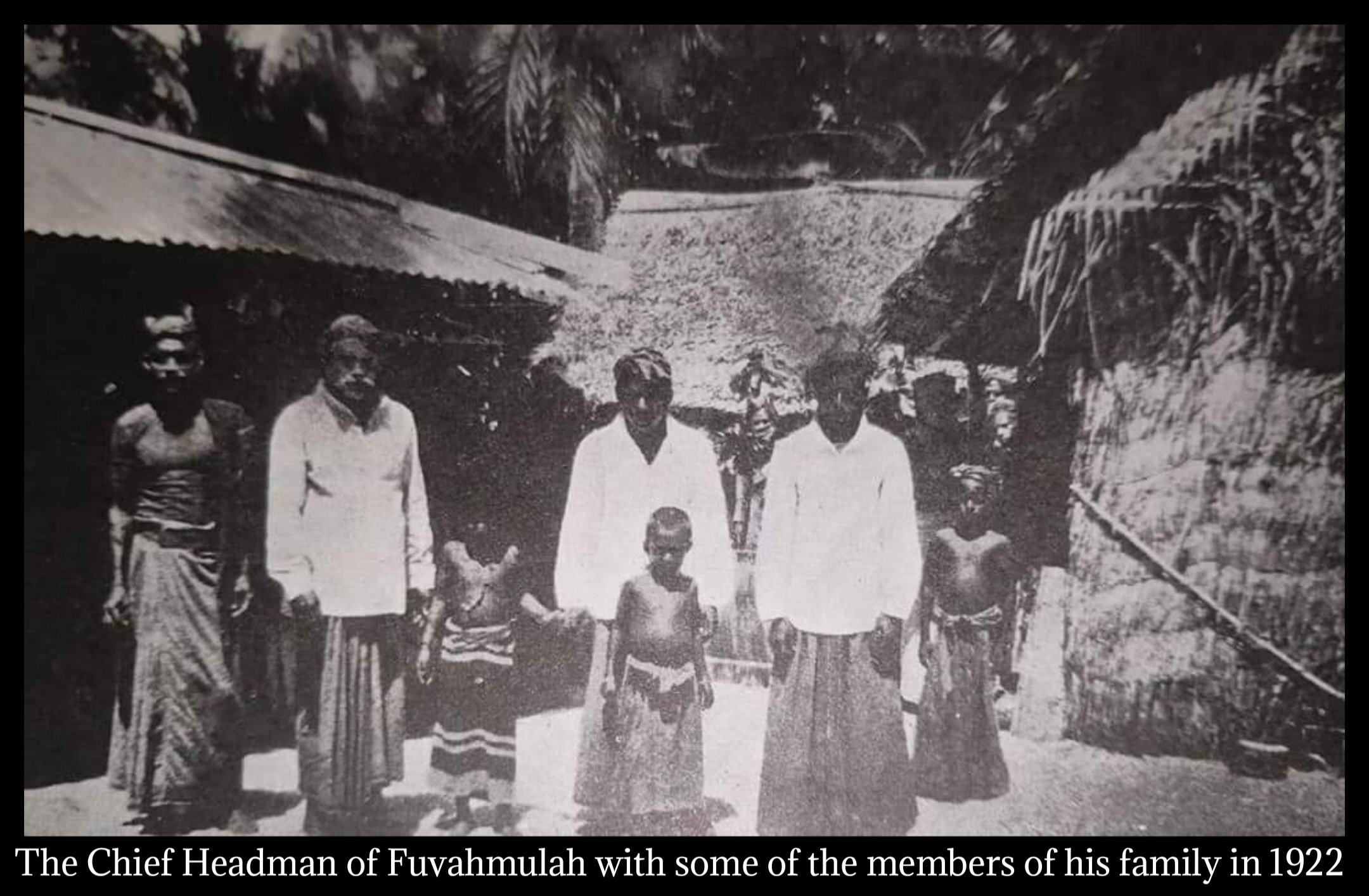
Although Fuvahmulah had a Vaaruverin (Government Tax Collector), unlike most Maldivian islands a century ago, its citizens were spared from Vaaru (poll-tax). However, a very low tax, Varuvaa, was levied on island-produced products. Except for the annual supply of 125 feyli (waist clothes) woven on the island and the delivery of less than 200 kottey of cowries, the only other exaction is a significant indent (12000 or more) for two types of the Maldivian bon'dihaluva.
Although Fuvahmulah lacked a harbour and was one of the most isolated islands in the Maldives a century ago, its residents never lived in isolation from other Maldivians. Along with fishing, Fuvahmulah inhabitants traveled by boat to Male' and other atolls, as well as abroad. Fuvahmulah at the time possessed four Naalu Odi (traditional freighters). There were also two Naalu Battheli (a smaller variety freight vessels). They also utilized 31 largers Dhoanis, 23 smaller Dhoanis, and 6 Bokkura.
According to Bell, at the very north end of the island, on the eastern beach, there was a ruined Buddhist Dagaba known to the islanders as Havitta.He described it as dilapidated and gutted, but that the majority of the lower coral masonry that surrounds it remained on one side of its circumference, albeit significantly dislocated and teetering on the brink of collapse. At the time, the Havitta stood 25 feet tall with a circumference of approximately 195 feet. According to Bell's writings, other ancient structures are thought to exist around the Havitta.
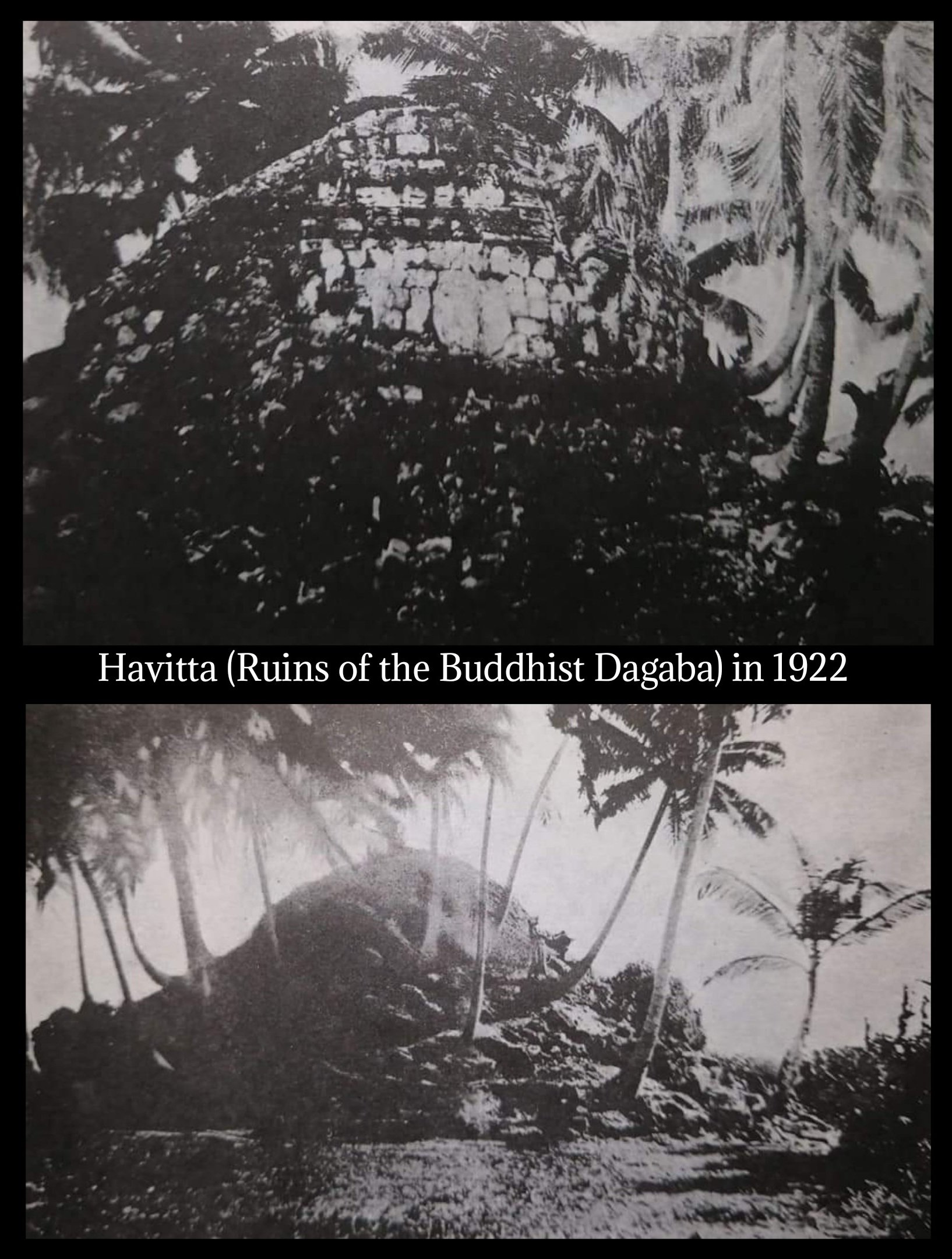
Given the facts stated above, Fuvahmulah was the most populous island in the Maldives 100 years ago, following Male'. It was a flourishing island where people were self-sufficient, who produced commodities, traded, and led comfortable lives. Fuvahmulah a hundred years ago was a green, environmentally friendly island.
Fuvahmulah, one of the two atolls south of the equator, is the country's third-largest island. Its area is roughly 5 square kilometers. Fuvahmulah features two inland freshwater lakes. Fuvahmulah, which is surrounded by a reef but lacks a lagoon, is the closest to Addu Atoll, followed by Huvadhoo. In addition to its size, Fuvahmulah boasts a sizable population. It is the third-most populous island in the Maldives.

The main sources for this article about Fuvahmulah a century ago are H.C.P. Bell's "The Maldive Islands. Monograph on the History, Archaeology and Epigraphy" and a study based on Maldives census data from 1921. H.C.P. Bell visited the Maldives three times, gathering detailed information, conducting research, and producing books and articles on the Maldives. He came to the Maldives in 1879, 1920, and 1922. During his third voyage, he also visited Fuvahmulah.
Looking back a century, Fuvahmulah was considerably different from what it is today. The image below the headline also beautifully depicts the difference between today's Fuvahmulah and what it looked like half a century ago. That photograph was taken 49 years ago by Richard Harcourt, who worked at the British Royal Air Force Base in Gan, Addu Atoll. The original photo was black and white. It was colorized by Ahmed Saffah. Fuvahmulah would have looked the same even a century ago, despite the fact that the photo was taken 49 years ago.
Fuvahmulah had no harbour or airport a century ago. At the time, there were three channels to reach this island, which was surrounded by a shallow reef where large waves broke. These included Dhiarehifaa'ndu, Maaneyru, and Rasgefandnu. Rasgefandnu was the most commonly used channel.
Bell stated that at the time, the island was regarded to have the most lush vegetation and fertile soil in the Maldives. The island was primarily a jungle, dominated by coconut trees. Because there were lots of trees in the courtyards of the houses and no roads like there are now, one would not see it from above as a thickly populated island. The people of the Maldives back then had a great passion for trees and led eco-friendly lives. They wouldn't uproot a tree unless it was absolutely required. More trees would be planted than taken down.
The population of Fuvahmulah was little over two thousand a century ago. The 1921 census states that there were 2,186 people living in Fuvahmulah at that time, 1,143 of them were men and 1,043 of whom were women. It had the largest population at the time, after Male'. Hithadhoo, Addu Atoll, which is currently in second position, had 1,771 residents at that time.
As previously stated, because Fuvahmulah was such a fertile and large island, agriculture was the primary employment for the majority of the population. In this regard, a total of 560 persons, including 317 women and 243 men, were working in agriculture. The island was home to 162 fishermen during those days and there were 105 persons working as toddy tappers. These two occupations were primarily male-dominated.
Around a century ago, among the people of Fuvahmulah who worked in various occupations for a living, there were 72 women involved in lace making and stitching, as well as one woman and 41 men in clothes weaving. There were also 22 male carpenters, 13 male blacksmiths, 7 male goldsmiths, 2 male fandithaverin (traditional healers), and 6 men and 5 women who worked as traditional medicine practitioners. At the time, Fuvahmulah was said to have only one midwife and one astrologer. Seven men and six women were involved in teaching the Holy Quran. Only one person on the entire island wove cadjan, and one person made fishing nets. While 18 men worked as traders on the island, 172 individuals were employed as servants, which included 113 women and 59 men.
Bell stated that Ahmad Didi, a great-grandson of Prince Ibrahim Faamuladheyri Kilagefaanu (son of Sultan Muhammad Ghiyasuddin), was engaged in stone carving, specifically in the making of tombstones, despite the occupation not being recorded separately in the census. Bell, who visited the island in 1922, stated that there was only one blacksmith at the time, Fengan'dumagu Muhammad Didi, despite the 1921 census listing thirteen blacksmiths. Bell may have visited the island when the other blacksmiths were away.
When Bell visited, he noticed that a small and completely unexpected industry had begun on the island. That was soap making. According to Bell, this locally produced soap was created using ashes, coral lime, and coconut oil. Soaps were offered to him in three colours: cream, mauve, and pink, with oblong or oval shapes. According to him, the design was well-executed. The words "Mulaku" or "Sábun Mulaku" (meaning "Soap of Mulaku") were written in Arabic on an oval or diamond-shaped panel. Occasionally, the owner's name, "Ahmad Didi," "Best Soap," and "Made in Mulaku" appear, with every word capitalized in English.
Fuvahmulah had 560 farmers, however they did not grow grains. The farmers primarily produced tuber crops. In addition, they grew various fruits and vegetables. According to Bell, in addition to coconut palms, breadfruit, and bananas, Fuvahmulah grew mango, custard apple, rose apple, jamun, pineapple, and citrus fruits. Bell claims that there is no evidence that the island has ever experienced food shortages. It was a self-sufficient island with a surplus of what was generated on its land and got from the sea.
Fuvahmulah was administratively divided into 'avah' or wards, like are the other major islands in the Maldives. At the time, there were nine wards on the island. The wards were: Dhadimagu, Dhiguvaan'du, Hoadhadu, Dharhukubaa, Maadhadu, Maalegan, Dhoodigan, Miskiymagu, and Funaadu. These nine wards had a total of 443 houses. This consisted of one Naaibuge (court house), thirteen Edhuruge (teaching houses), and eleven medicinal houses. During this time, only one house in Fuvahmulah was constructed of coral stone and roofed with corrugated iron sheets. There were 14 coral stone houses with thatch roofs, while the others were made of thatch and wood. There were 48 Maizaange (public assembly houses) in Fuvahmulah at the time.
According to the census of 1921, Fuvahmulah had 26 mosques. However, Bell said that there were 25 mosques. The two largest mosques were the Hukuru Miskih (Jumah or Friday Mosque) in Maalegan and the Eidhu Miskih (Eid Mosque) in Dhadimagu. The Eid Mosque was locally known as Gen Miskih. According to Bell, the island's oldest mosques were Henehari Miskih, Hoadhadu Miskih, Kedeyre Miskih, and Ufurajehi Miskih. However, historians believe that the oldest mosque is Gen Miskih, which was built by Abu Bakuru Naaib Kaleygefaanu, who introduced Islam to the island. The mosques Bell describes were constructed much later. In any case, because this essay is about Fuvahmulah a hundred years ago, we will not go into detail about the island's early history.

Each mosque, like all other islands in the Maldives at the time, had an attached cemetery or graveyard. In addition, there were a few additional cemeteries spread over the island. Fuvahmulah had a total of 35 cemeteries according to the 1921 census.
In ancient times, one special structure associated with mosques in the Maldives was the stepwells or the bathing tanks located mostly near the mosques. There were a lot of these stepwells at the larger, primary mosques and other public places on the island. There were also stepwells in private residences on a few islands. A hundred years ago, the island with the most stepwells in the Maldives was Fuvahmulah, with 426 stepwells. During that time, there were a total of 1,880 stepwells across all islands in the Maldives. Along with Fuvahmulah, the atolls with the most stepwells in the Maldives were Addu Atoll, Huvadhoo Atoll, and Male'. This included 426 stepwells in Fuvahmulah, 567 in Addu Atoll, 594 in Huvadhoo Atoll, and 77 in Male', totaling 1,664 stepwells. This accounted for approximately 90% of all stepwells in the Maldives.

In the 1930s, a law was passed to remove public stepwells from islands throughout the Maldives, and as a result, the stepwells in Fuvahmulah were filled up, buried, or demolished. The World Health Organization's recommendations resulted in the eradication of practically all stepwells in the southern Maldives by 1952; the stepwells that remained in Fuvahmulah were either buried or demolished.
Like every other island in the Maldives at the time, Fuvahmulah was home to a large number of shrines and Ziyaaraths (tombs) of notable people. Five of these ziyaaraths were thought to be the most special, according to Bell. He did not, however, include all of the names of these ziyaaraths. He did, however, note that Abdu Naaib Kaleygefaanu's shrine was the most revered.

Bell reported that there were eight Katheebs in Fuvahmulah for leading religious services, such as Friday and Eid prayers in the mosques; however, the census records only listed six Katheebs. This difference could be attributed to the absence of some Katheebs from the island, vacant positions, or other factors. Like the Hukuru Miskiiy (Friday Mosque) in Male', the Hukuru Miskih (Friday Mosque) in Fuvahmulah also had a Maa Mudhim and five lessor Mudhims working under him, in addition to a Malin.
A Naaibu (Deputy) served as the senior officer in charge of Fuvahmulah's judiciary at the time. This Naaibu was, in fact, a subordinate judge serving as a deputy of the Chief Justice of the Maldives. However, at the time, only the Chief Justice in Male' was referred to as a judge (Fan'diyaaru), and those who worked under him were referred to as Naaibus. The aforementioned Naaibu in Fuvahmulah was assisted by four Dheyvanis.
The Goiverin was in charge of supervising government-owned land (Bandaara bin) revenues in Fuvahmulah. Bell claims he was also the island's highest-ranking government official or the Chief Island Headman. Ali Didi, the son of Hirihamaadhi Kaleygefaanu, served as Fuvahmulah's Goiverin a century ago. However, some historians believe that, like other Maldivian atolls, Fuvahmulah's highest-ranking official at the time was a Vaaruverin (Government Tax Collector). According to them, Ali Didi was the Vaaruverin, as well as the Goiverin. In atolls with Vaaruverin, there were also separate Goiverin who managed and supervised the bandaara lands.

Although Fuvahmulah had a Vaaruverin (Government Tax Collector), unlike most Maldivian islands a century ago, its citizens were spared from Vaaru (poll-tax). However, a very low tax, Varuvaa, was levied on island-produced products. Except for the annual supply of 125 feyli (waist clothes) woven on the island and the delivery of less than 200 kottey of cowries, the only other exaction is a significant indent (12000 or more) for two types of the Maldivian bon'dihaluva.
Although Fuvahmulah lacked a harbour and was one of the most isolated islands in the Maldives a century ago, its residents never lived in isolation from other Maldivians. Along with fishing, Fuvahmulah inhabitants traveled by boat to Male' and other atolls, as well as abroad. Fuvahmulah at the time possessed four Naalu Odi (traditional freighters). There were also two Naalu Battheli (a smaller variety freight vessels). They also utilized 31 largers Dhoanis, 23 smaller Dhoanis, and 6 Bokkura.
According to Bell, at the very north end of the island, on the eastern beach, there was a ruined Buddhist Dagaba known to the islanders as Havitta.He described it as dilapidated and gutted, but that the majority of the lower coral masonry that surrounds it remained on one side of its circumference, albeit significantly dislocated and teetering on the brink of collapse. At the time, the Havitta stood 25 feet tall with a circumference of approximately 195 feet. According to Bell's writings, other ancient structures are thought to exist around the Havitta.

Given the facts stated above, Fuvahmulah was the most populous island in the Maldives 100 years ago, following Male'. It was a flourishing island where people were self-sufficient, who produced commodities, traded, and led comfortable lives. Fuvahmulah a hundred years ago was a green, environmentally friendly island.





